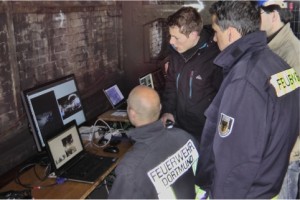TRADR representatives in discussion with visitors in front of the TRADR stand at the exhibition of EU robotics projects during IROS 2015, September 28 – October 02, 2015, in Hamburg, Germany.
Archive for: ‘September 2015’
Second TRADR Evaluation Exercise
Teamwork between robots and firefighters during 2nd TRADR evaluation exercise in Dortmund
In September 2015 the 2nd TRADR Evaluation Exercise (TEval) was held in Dortmund, Germany, at an old industrial complex of a former blast furnace, in collaboration with Dortmund firefighters. The EU FP7 TRADR project develops technology for human-robot teams to assist in disaster response efforts, over multiple missions. Two types of robots – Unmanned Ground Vehicles (UGV) and Unmanned Aerial Vehicles (UAV) – work together with human firefighters. The TRADR consortium consists of nine research partners and three end-user organizations from different European countries. TU Delft is responsible for human-robot teaming.
The purpose of the exercise was to evaluate how well the TRADR system is able to support firefighters in a disaster response mission. The exercise was part of an incremental research and development cycle through which the technology – robots capabilities as well as related infrastructure – is gradually maturing.
Compared to last year’s exercise, new aspects included:
- A more integrated GUI for human operators (the GUI system was redeveloped from scratch to better fit in with the rest of the system).
- Integrated audio communication for human team members (as opposed to Walkie–Talkies).
- Improved data persistence: data collected in previous sorties could be re-used.
- More advanced robot capabilities, such as:
- Autonomous mapping and localization (SLAM), where the maps could be reused at a later stage.
- Autonomous driving of the UGV based on way-points indicated by an operator.
- A robotic arm mounted on top of the UGV to manipulate objects in the field.
- Automated victim detection.
- More advanced visuals, including 3D point cloud maps and thermal cameras to detect heat sources.
In addition to testing the integrated system from a technical point of view, valuable feedback was collected from the firefighters. Overall they were favorably regarding the potential of the system, and in addition helped identify points for improvement. The gathered data and experience will feed into the next system’s iterations.


